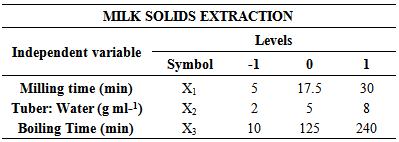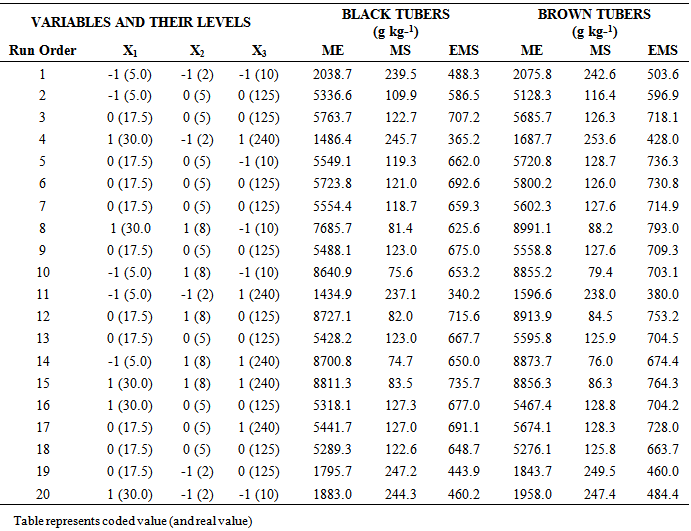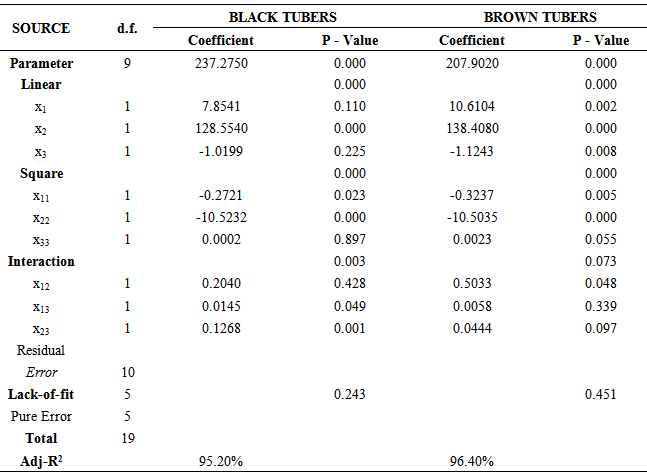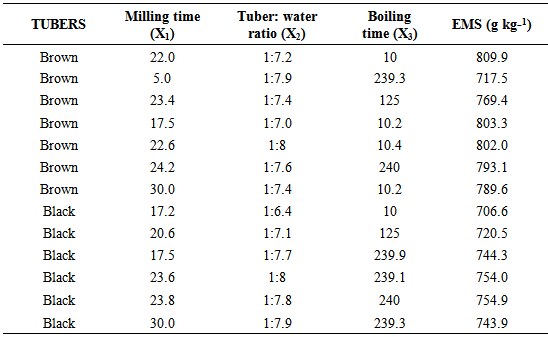| [1] | Arranz, I., Stroka, J. and Neugebauer, M. (2006) Determination of aflatoxin B1 in tiger nut-based soft drink. Food Additive and Contaminants, 23, 305-308. |
| [2] | Glew, R.H., Glew, R.S., Chuang, L.-T., Huang, Y.-S., Millon, M., Constans, D. and Vanderjagt, D.J. (2006). Amino acids, minerals and fatty acids content of pumpkin seeds (Cucurbita spp) and Cyperus esculentus nuts in the Republic of Niger. Plant Foods and Human Nutrition, 2006; 61, 51-55, Springer Science+Business Media, Inc. DOI: 10.1007/s11130- 006-0010-z. |
| [3] | Abbiw, D. (1990) Useful Plants in Ghana. Pp 30, Southampton Row, London, Intermediate Technology Publications Ltd. |
| [4] | Dokosi O.B. (1998). Herbs of Ghana pp 548, 549, Accra, Ghana University Press. |
| [5] | Cortés, C., Esteve, M. J., Frgola, A. and Torregrosa, F. (2004).Physical and chemical properties of different commercially available types of “horchata de chufa”. Italian Journal of Food Science, 1, 113-121. |
| [6] | Yeboah, S.O., Mitie, Y.C., Ngila, J.C., Wessjohann, L. and Schmidt, J. (2011) Compositional and Structural Studies of the Oils from Two Edible Seeds: Tiger nut, Cyperus esculentum, and Asiato, Pachira insignis, from Ghana, Food Research International, doi: 10.1016/j.foodres; 06.036. |
| [7] | Belewu, M. A. and Belewu, K. Y. (2007) Comparative Physico-Chemical Evaluation of Tiger-nut, Soybean and Coconut Milk Sources. International Journal of Agriculture Biology, 9, 785-787. |
| [8] | Dubois, V., Breton, S., Linder, M., Fanni, J. and Parmentier, M. (2007). Fatty acid profiles of 80 vegetable oils with regard to their nutritional potential. European Journal of Lipid Science and Technology.109: 720–32. |
| [9] | Mosquera, L. A., Sims, C. A., Bates, R. P. and Okeefe, S.P. (1996): Flavor and stability of Horchata De Chufas. Journal of Food Science, 1, 856-861. |
| [10] | Pascual, B., Maroto, J.V., Lópex-Galarza, S., Sanbautista, A. and Alagarda, J. (2000) Chufa (Cyperus Esculentus l. var. Sativus Boeck.): An unconventional crop. Studies related to applications and cultivation, Economy Botony, 54, 439-448. |
| [11] | Cortés, C., Esteve, M. J., Frgola, A. and Torregrosa, F. (2005) Quality characteristics of horchata (a Spanish vegetable beverage) treated with pulsed electric fields during shelf- life. Food Chemistry, 91, 319-325. |
| [12] | Mordi, J. I., Ozumba, A.U., Elemo, G.N. and Olantunji, O. (2010)Physicochemical and Sensory evaluation of Nigerian Tiger-Nut Extract Beverage. Bioscience Resource Communication, 22,203-207. |
| [13] | Rubert, J., Sabastià, N., Soriano, J. M., Soler, C. and Mañes J. (2011) One-year monitoring of aflatoxins and ochratoxin A in tiger-nuts and their beverages. Food Chemistry, 127, 822-826. |
| [14] | Corrales, M., de Souza, P. M., Stahl, M.R. and Fernandez, A. (2012). Effect of the decontamination of a fresh tiger nuts’ milk beverage (horchata) with short wave ultraviolet treatments (UV-C) on quality attributes. Innovation Food Science and Emerging Technology, 13, 163-168. |
| [15] | Djomdi Ejoh, R., and Ndjouenkeu, R. (2006) Characteristics of tigernuts (Cyperus Esculentum) tubers and their performance in the production of a milky drink Journal of Food Process and Preservation, 30, 145-163. |
| [16] | Sanful, R.E. (2009). Production and sensory evaluation of tigernut beverages Pakistan Journal of Nutrition; 8, 688-690. |
| [17] | Adekanmi, O. K., Oluwatooyin, O. F. and Yemisi, A. A. (2009). Influence of Processing Techniques on the Nutrients and Antinutrients of Tigernut (Cyperus esculentus L.) World Journal of Dairy and Food Science, 4, 88-93. |
| [18] | Rhee, K.C., Cater, M.C. and Matil, K.F. (1972) Simultaneous recovery of protein and oil from raw peanuts in an aqueous system Journal of Food Science, 39, 90. |
| [19] | Kim, S.H. (1989). Aqueous extraction of oil from palm kernel Journal of Food Science, 54, 491,492. |
| [20] | Arifin, J., Bono, A., Farm, Y.Y., Ling, A.L.L. and Fui, S.Y. (2009) Protein extraction from palm kernel meal Journal Applied Science,; 9, 2996-3004. |
| [21] | Milani, E., Koocheki, A. and Golimovahhed Q.A. (2011). Extraction of inulin from Burdock root (Arctium Lappa) using high intensity ultrasound. International Journal of Food and Technology, 46, 1699-1704. |
| [22] | Ye, C. and Jiang, C. (2011) Optimization of extraction process of crude polysaccharides from Plantago asiatica L.by response surface methodology. Carbohydrate Polymer, 84, 495-502. |
| [23] | Montgomery, D.C. (2001) Design and Analysis of Experiments. New York: John Wiley and Sons. |
| [24] | Er, F. Ozcan, M.M., Gumuscu, A., Arslan, D. and Unver, A. (2009). The influence of planting time and planting closeness of ground almond (Cyperus esculentus l.) populations on some agronomuic and quality properties. A World Applied Science Journal, 6, 616-623. |
| [25] | Akintunde, T.Y. T. and Akintunde B.O. (2002). Development of models for predicting the yield quality of soymilk The Journal of Food Techenology Africa, 7, 55-58. |
| [26] | Kuila, A., Singh, A., Mukhopadhyay, M. and Banerjee R. (2011) Process optimization for aqueous extraction of reducing sugar from cashew apple bagasse: A potential, low cost substrate. LWT – Food Science and Technology, 44, 62-66. |
| [27] | Ndjouenkeu, R. and Djomdi, Ejoh, R. (2007) Soaking behavior and milk extraction performance of tiger nut (Cyperus esculentus) tubers. Journal of Food Engineering, 78, 546-550. |

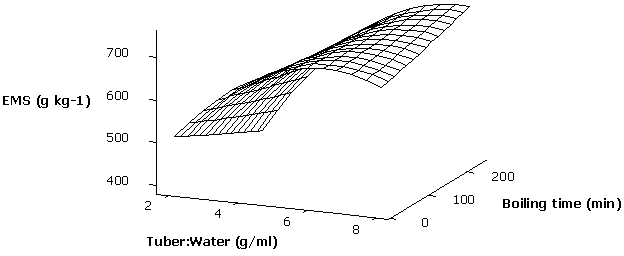
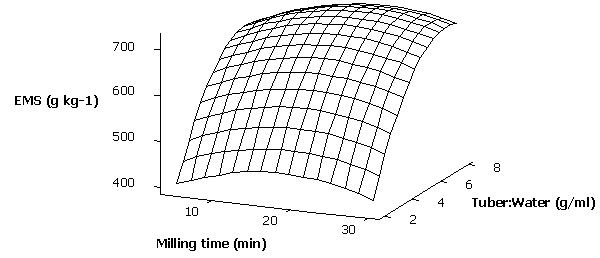
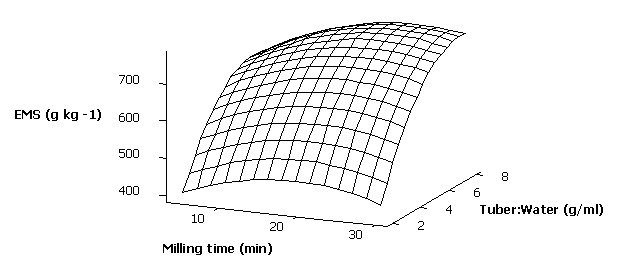
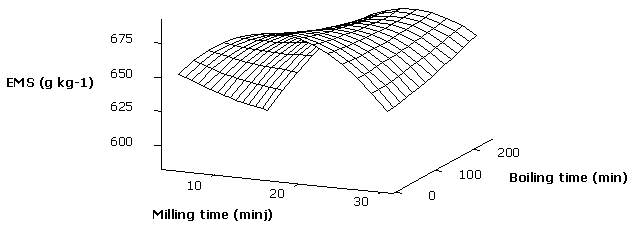
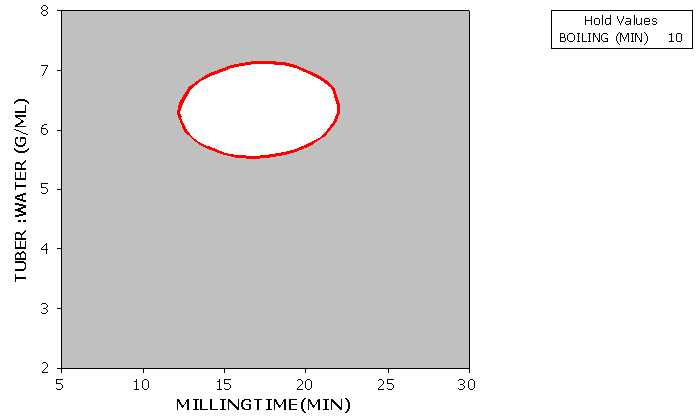
 Abstract
Abstract Reference
Reference Full-Text PDF
Full-Text PDF Full-text HTML
Full-text HTML